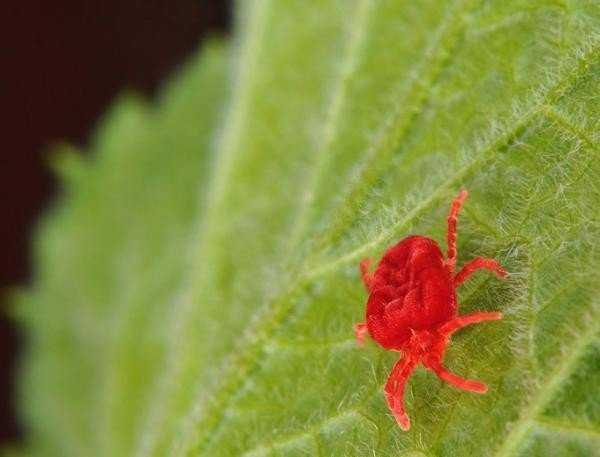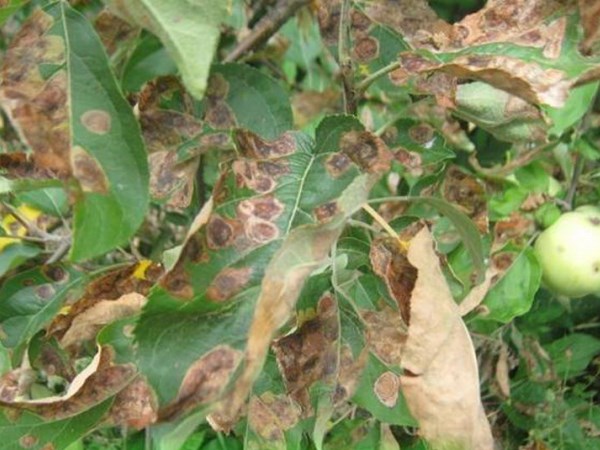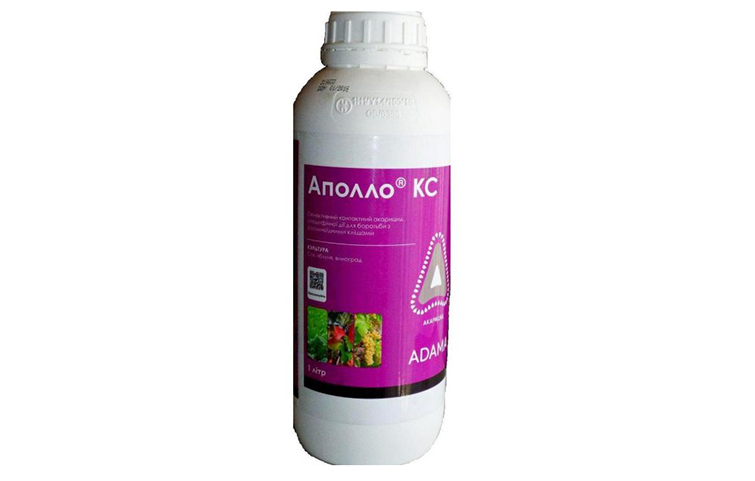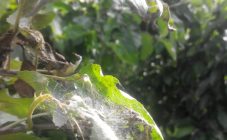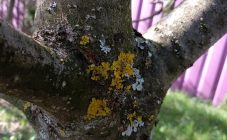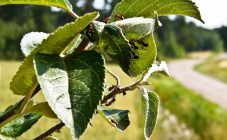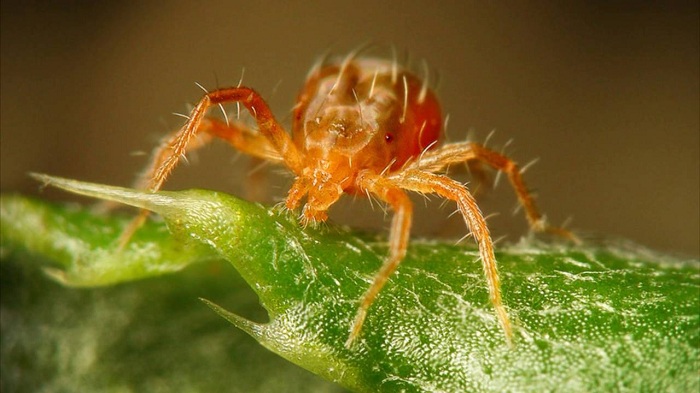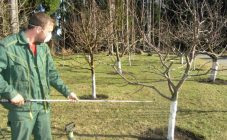Content:
One of the favorite fruit crops is the apple tree, which from year to year pleases the owner of the plot with a harvest of sweet apples. However, sometimes the crop can be damaged by pest attacks. One of the most dangerous is the spider mite. Its appearance can provoke a decrease in plant immunity, which will entail greater susceptibility to fungal, infectious and viral diseases.
Signs of the presence of a pathogen
First of all, it should be said that the spider mite is an arachnid insect, the size of which does not exceed 1 mm. In favorable conditions, it can give up to 5 generations per season. The pest feeds on plant juices, causing leaves to fall. In advanced cases, you can completely lose the crop.
The most common are several types of ticks:
- Red fruit, up to 0.4 mm in size. You can notice the defeat of such a mite by the appearance of light spots along the veins of the leaves, after which the leaf turns brown and falls off. The presence of large mite colonies is evident from the thin whitish cobweb on the underside of the leaf;
- Brown fruit mite - up to 0.6 mm. Sucking the juice from the leaves and buds, it gives them a rusty or gray color, after which the shoots fall off;
- Gall mite has the smallest size, up to 0.25 mm. It lives in the thickness of plant tissues. It got its name due to the fact that after tissue damage, galls form on the surface of the leaves - swollen balls of a dirty brown color. After such exposure, the leaves begin to blacken and die off;
- Kidney mite... As the name suggests, young shoots are targeted. This is the most dangerous species. Because of it, the plant stops growing or forms damaged shoots.
Consequences of untimely treatment of trees
Microscopic dimensions impose restrictions on the detection of the pest in the early stages of tree damage. A spider mite on an apple tree multiplies very quickly, from the moment of laying eggs to reaching puberty, an average of a week occurs. Such rapid reproduction entails a great danger to plants:
- loss of part of the foliage - with the development of the mite population, the tree may lose half of its leaves by the middle of the season;
- lowering the immunity of the tree;
- loss of yield due to kidney damage by a mite;
- susceptibility to viral and fungal diseases;
- with a large-scale development of a tick colony, plant death is possible.
Treatment methods for damaged plants
There are several groups of measures to combat spider mites on an apple tree:
- chemical products;
- biological products;
- agrotechnical means;
- folk recipes.
Currently, there are a huge variety of different chemicals on the market to help fight insect pests - insecticides. Separately, there is a product specializing in mites - acaricides. Such substances can be purchased in the form of emulsions, suspensions, aqueous solutions or soluble powders. As a rule, diseased plants are sprayed with insecticides.
When using acaricides, you should choose drugs aimed at destroying only the causative agent of the disease (Sunmayt SP, Omayt SP and others).The use of substances with a wide range of effects can lead to the death of beneficial insect species. Chemical processing entails some consequences, for example, the preservation of a residual amount of a substance in the final product, pollution of natural resources.
The biological method is based on the use of drugs based on the waste products of fungi of the genus Streptomyces (Apollo, Fitoferm and others). Such preparations are active in the warm season and are characterized by a short aging period before harvesting. The disadvantage of this method is that it affects only adults of ticks without destroying eggs and larvae.
Agrotechnical method consists in mechanical removal of damaged branches and subsequent burning. It is necessary to thoroughly clean the branches from the falling bark, where the ticks can wait out unfavorable conditions. A radical way is to prune infected shoots. This method should be used as a last resort, when other means have not been successful, and there is a threat of death of the entire tree.
For a long time, folk remedies have been used to combat the tick. Some recipes are listed below:
- Insist 50 g of peeled heads of garlic in 10 liters of water, add liquid soap and spray the leaves from top to bottom;
- dilute 100 g of tar soap into 10 liters of water, spray once a week;
- for 1 hour, insist 200 g of onion husks in a bucket of water, strain and spray the plant;
- boil 100 g of hot pepper in 1 liter of water, insist for a day. For processing, use 8 ml of broth per 1 liter of water;
- dilute 200 g of tobacco in 5 liters of water and insist for a day, boil for 2 hours and strain; Dilute with water in a ratio of 1: 1 and add 50 g of tar soap;
- finely chop 400 g of horseradish into a bucket of water, leave for 2-3 hours, spray the tree;
- boil fresh black henbane for several hours in a small volume of water, dilute the resulting broth with 10 liters of water; use with caution, because henbane is a poisonous plant.
Preventive measures
There is an effective scheme for treating plants during the entire growing season to prevent tick damage to trees:
- Until the first buds open in the spring, the trunk and branches should be treated for overwintered ticks. Usually, a solution of copper sulfate is used for this. In addition, you can cultivate the near-trunk soil, since pests can overwinter, buried in the ground;
- Before the flowering period, carry out the following processing. For this, any of the preparations of insecticides or acaricides is suitable;
- Processing during the flowering period is undesirable. It can provoke the death of pollinating insects and negatively affect productivity;
- From the beginning of fruit growth, the following insecticide treatment is carried out;
- After the end of the harvest and before the leaves fall, the tree should be treated with a solution of copper sulfate or urea to get rid of the ticks remaining for the winter;
- Whitewashing tree trunks every season helps to exterminate hibernating ticks and their egg-laying;
- Regular mineral fertilizing stimulates the immunity and resistance of the tree;
- Correct pruning of shoots stimulates tissue regeneration;
- Active reproduction of the tick occurs in dry and hot weather, so regular sprinkling can counteract the spread of pests.
Summing up, we can say that the attack of a spider mite on apple trees is an unpleasant disease that requires a thorough multifaceted treatment. A complex of treatments for crops with insecticides will help to quickly and efficiently get rid of the tick population.It should be remembered that with timely feeding, maintaining the correct irrigation regime and sprinkling, plant immunity will be maintained at an optimal level. Such a tree is less susceptible to attack by pests. The cultivation of the soil adjacent to the trunk and the application of mineral fertilizers will help to exterminate the mite culture that hibernates in the soil. Combined methods of prevention, correct agricultural technology, and the implementation of acaricidal treatments at the proper time will help keep the abundant harvest and the fruit-bearing tree itself intact.
